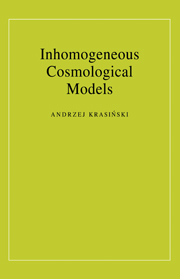Book contents
- Frontmatter
- Contents
- List of illustrations
- Preface
- Acknowledgements
- 1 Preliminaries
- 2 The Szekeres–Szafron family of solutions
- 3 Physics and cosmology in an inhomogeneous Universe
- 4 The Stephani–Barnes family of solutions
- 5 Solutions with null radiation
- 6 Solutions with a “stiff fluid”/scalar field source
- 7 Other solutions
- 8 Averaging out inhomogeneities of geometry and matter in cosmological models
- 9 Comments
- Appendix A Dictionary of abbreviations used in the text and in the diagrams
- Appendix B Why should one consider inhomogeneous models of the Universe?
- Appendix C Memorable statements about the cosmological principle
- Appendix D How was this review compiled?
- Appendix E Historical milestones
- Notes added in proof
- Bibliography
- Index
3 - Physics and cosmology in an inhomogeneous Universe
Published online by Cambridge University Press: 03 May 2010
- Frontmatter
- Contents
- List of illustrations
- Preface
- Acknowledgements
- 1 Preliminaries
- 2 The Szekeres–Szafron family of solutions
- 3 Physics and cosmology in an inhomogeneous Universe
- 4 The Stephani–Barnes family of solutions
- 5 Solutions with null radiation
- 6 Solutions with a “stiff fluid”/scalar field source
- 7 Other solutions
- 8 Averaging out inhomogeneities of geometry and matter in cosmological models
- 9 Comments
- Appendix A Dictionary of abbreviations used in the text and in the diagrams
- Appendix B Why should one consider inhomogeneous models of the Universe?
- Appendix C Memorable statements about the cosmological principle
- Appendix D How was this review compiled?
- Appendix E Historical milestones
- Notes added in proof
- Bibliography
- Index
Summary
In this chapter, those papers will be described which discuss physical and astrophysical implications of the various properties of inhomogeneous cosmological models. A great majority of the papers are based on the L–T model. Those considerations which are not based on any explicit solution are described in Section 3.9. Some more cosmological considerations, based on the McVittie (1933) solution, will be presented in Section 4.7. The papers are sorted by the subjects they discuss; each section is devoted to one subject; the sections are ordered in chronological order of the earliest contributions.
Formation of voids in the Universe
The first predictions that voids should form in an inhomogeneous Universe were formulated by Tolman (1934) and Sen (1934) on the basis of the L–T model. Tolman predicted it in just a casual remark (see quotation in Section 2.12), while Sen made a thorough study of stability of the static Einstein and the FLRW models with respect to the L–T perturbation, and concluded explicitly that “the models are unstable for initial rarefaction”.
In a follow-up paper, Sen (1935) considered the influence of pressure on the stability. That investigation is based on the Einstein equations in a spherically symmetric perfect fluid spacetime, without invoking any explicit solution. Depending on the spatial distribution of pressure, stability may be restored or instability enhanced, but this observation is not developed further.
Bondi (1947) predicted the formation of voids in just one phrase: “… if originally there is a small empty region round O and if the matter nearest to O does not move inward at first … then it will never move inwards”.
- Type
- Chapter
- Information
- Inhomogeneous Cosmological Models , pp. 100 - 141Publisher: Cambridge University PressPrint publication year: 1997

